Headquarters Train & Signal Corps at Camp Devens - 1918
The 301st Headquarters Train and Military Police embraces four other organizations: the 301st Supply Train, the 301st Ammunition Train, the 301st Sanitary Train and the 301st Engineers’ Train.
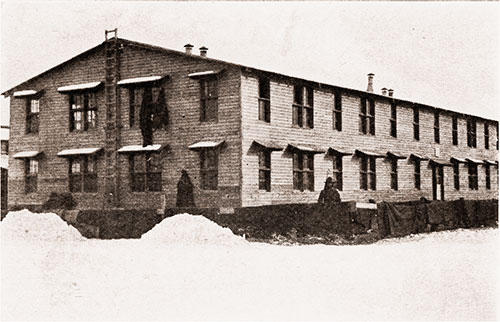
The Quarantine of the Ammunition Train Company at Camp Devens. GGA Image ID # 13a2f5cfc1
The medical authorities have also taken strict precautions to prevent the spread of any epidemic among the draft men. The few and scattered cases of measles have resulted in the wholesale quarantine of the companies to which the sick men belonged.
This picture shows the quarantined barracks of a caisson company of the Ammunition Train. A promenade has been fenced in for the guard; he will allow no one to come within the outside fence, and the patients are restricted to that area enclosed by the inside barrier.
THE HEADQUARTERS TRAIN— THE SIGNAL CORPS
The 301st Headquarters Train and Military Police embraces four other organizations: the 301st Supply Train, the 301st Ammunition Train, the 301st Sanitary Train and the 301st Engineers’ Train.
The members of these motorized units come principally from Worcester, Spring- field, and the central part of Massachusetts. Many experienced drivers and skilled mechanics have been transferred to the Headquarters Train and are employed at their old trades.
This is in accordance with the plan of the authorities to put every man where he will do the best work. The Commanding Officer is Colonel G. H. Estes, formerly of the infantry.
The signaling department of the camp is under the control of Major C. A. Lewis, the divisional signal officer. Captain John F. Fanning commands the 301st Signal Battalion, the only detachment of the Signal Corps at Ayer.
This battalion is unlike the other units in that its members are, for the most part, volunteers who were recruited last spring and early summer before the draft became effective. The equipment of the Corps includes a complete wireless outfit which communicates frequently with other stations in all parts of the country.
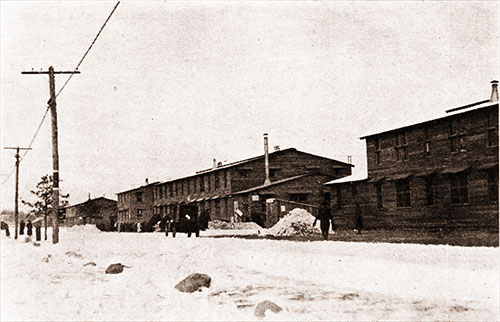
The Main Street and Some of the Barracks of the Headquarters Train. GGA Image ID # 13a47b1c80
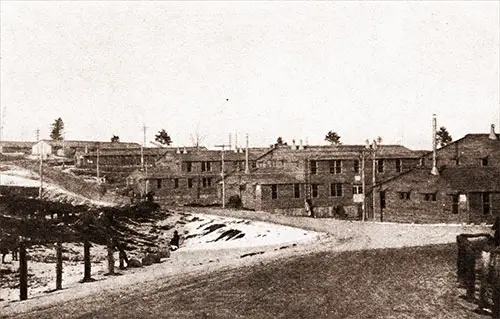
A View of the Barracks of the 301st Signal Battalion. The First Three Belong to Companies A, B, and C, Respectively; The Building Beyond, Which Resembles an Officers’ Quarters, Is That of the Headquarters Detachment. GGA Image ID # 13a55f5a48
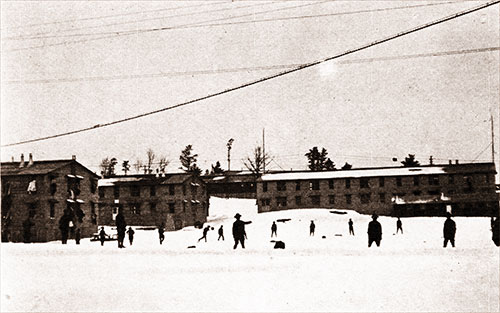
Another View of the Signal Corps, Showing the Drill Field. The Building in the Background, Upon Which the Antennae of the Wireless Are Seen, Is for the Overflow From the Three Other Buildings. the Wireless, Which Is Now in the Officers’ Quarters, Will Also Be Moved Into the New Structure. GGA Image ID # 13a59c86db
THROWING THE MEDICINE BALL
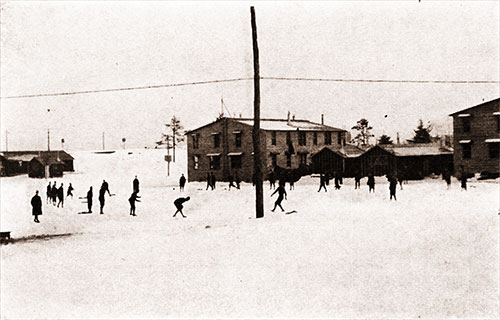
Men from the Signal Corps Throwing a Heavy Medicine Ball Around. GGA Image ID # 13a7ebc6f3
Outdoor games are often substituted for the setting-up exercise. This circle of men from the Signal Corps is engaged in throwing about a heavy medicine ball.
The physical training of the camp is superintended by R. F. Nelligan, a civilian instructor, who was formerly the Professor of Hygiene and Physical Exercise at Amherst College. Mr. Nelligan offered his services to the War Department and was sent to Ayer in November.
